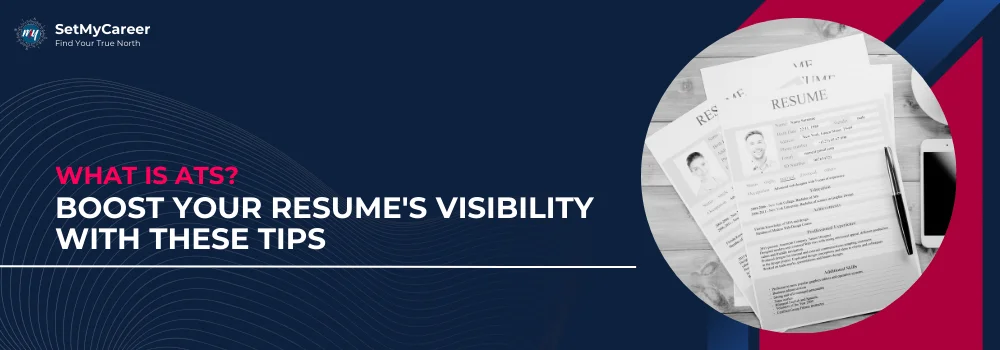Published by Jyothi Patil on 16 October 2024
Content Strategist | Editorial Team Member
Jyothi Patil is a skilled writer with a strong background in English literature, which she applies to crafting engaging content across various platforms. From writing blogs for her website and guest posts to creating pieces on Medium and Substack, Jyothi excels in making complex ideas easy to understand.
Discover what is ATS and how it can boost your chances of getting noticed by recruiters and help you land your next career opportunity.

In today’s job search process, getting your resume noticed can be more challenging than you think. Many companies now rely on Applicant Tracking Systems (ATS) to screen resumes before they even reach human eyes. These systems scan resumes for specific keywords and formatting, and only those that align with the job description make it to the next stage. Whether you’re a recent graduate preparing to enter the workforce or a seasoned professional looking to make your next career move, understanding how ATS works is essential.
By optimizing your resume to meet the criteria set by these systems, you can increase your chances of being seen by hiring managers. Let’s dive into practical tips that can help you ensure your resume stands out in both the ATS screening process and in front of the recruiter.
An Applicant Tracking System (ATS) is software used by employers to streamline the recruitment process by automating the initial stages of resume screening. ATS scans resumes for specific keywords, skills, qualifications, and job-related criteria that match the job description. The system sorts and ranks these resumes based on how well they align with the requirements of the position. As a result, only the resumes that meet the ATS’s criteria are passed along to hiring managers for further review.
For job seekers, especially those applying to large organizations, this means that a well-written resume might not even reach a human recruiter if it’s not formatted correctly or doesn’t contain the right keywords. Understanding how ATS works is crucial to ensuring your resume isn’t overlooked by these automated systems and stands a better chance of making it into the hands of decision-makers.
When it comes to CV writing, it's important to understand that Applicant Tracking Systems (ATS) are designed to scan resumes for key information. To make sure your resume passes through these systems, it's essential to focus on how your CV is formatted and the content it contains.
ATS scans for key details: such as your name, contact information, skills, work experience, education, and certifications.
Formatting is crucial: ATS may struggle with unconventional layouts, so use standard fonts like Arial or Calibri.
Avoid graphics and complex tables: Stick to a simple, text-based format to ensure the ATS can properly read and categorize your information.

Don’t let ATS filter you out—boost your chances with these tips
Get Noticed FasterOptimizing your resume for ATS is essential to ensure it passes through automated filters and reaches the hiring manager’s desk. Here are some key tips on how to write a resume to help you make your resume ATS-friendly:
Integrate specific keywords from the job description directly into your resume. ATS scans for specific terms, such as job titles, skills, and qualifications. For example, if the job description mentions "Project Management" and "Agile Methodology," make sure those exact phrases appear in your resume if they align with your experience.
Avoid using images, graphics, or complex layouts, as ATS systems may struggle to read them. For instance, instead of using a pie chart to show your skills, list them clearly in text form. For example - Skills: Project Management, Agile Methodology, Microsoft Excel.
Use conventional headings like “Work Experience,” “Education,” and “Skills” instead of creative alternatives such as “Professional Journey” or “Academic Background.” ATS is designed to recognize these standard headings and might miss important details if the heading is unconventional.
Customize your resume for each job application to match the specific skills and qualifications listed in the job posting. If a role requires "data analysis" experience, and you have it, make sure that phrase appears prominently in your resume.
Organize your experience and skills in bullet points rather than paragraphs to make it easier for the ATS to extract the relevant information. For example: Managed a team of 5 to execute multiple projects within budget and on schedule.
Stick to common, ATS-readable fonts like Arial, Calibri, or Times New Roman. Avoid using symbols or special characters, which may not be interpreted correctly by ATS. For example, replace any arrows or stars with simple bullet points.
Optimizing your resume for ATS can make a significant difference in your job search. By using the right keywords, formatting your resume simply, and personalizing it to each job, you can ensure that your application stands out both to the ATS and to recruiters. If you need expert career counselling on resume optimization, SetMyCareer is here to guide you along your career goals.
No. 14/595, 1st Floor, Nanjappa Reddy Layout, Koramangala 8th Block, Bangalore 560095